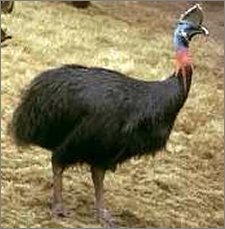Birds on a Plane: The Top 9 Most Dangerous Birds You Wouldn't Want to be Trapped on a Plane With
by www.SixWise.com
The new film Snakes on a Plane is a box office success
(whether it deserves to be or not is another question). Inevitably
there will be a sequel or two, or maybe ten. While it might
be Iguanas on a Plane or Squid on a Plane or
even Cows on a Plane, we're going to take an early
guess and say the next film will be called Birds on a Plane.
|

Cassowaries are big, unpredictable and aggressive ...
and their kicks are strong enough to break bones (oh,
and did we mention their dagger-like claws?).
|
If so, the director might want to consider using several
(or all) of the birds listed below, as these are nine
of the world's most dangerous birds.
1. Cassowaries
Cassowaries, an endangered species, are large, flightless
birds that live in the rainforests, woodlands and swamps of
Australia. Cassowaries are unpredictable, aggressive and are
known to kick up their large, clawed feet. Their kicks are
capable of breaking bones, and their claws have been likened
to daggers.
2. Ostriches
Ostriches are suspicious, skittish and can be dangerous.
They're the largest living bird (they can reach over 9 feet
tall and 350 pounds) and they can outrun you (a steady 30
miles an hour for 10 miles straight). Like the cassowary,
they have strong legs (their kick can kill a hyena) and sharp
claws.
3. Canada Geese
Canada geese are very aggressive and, particularly if you
(purposely or inadvertently) come near their nests or young,
they may chase you away and even bite you.
4. Seagulls
Seagulls are extremely aggressive and are known to attack
and even peck at people's heads to protect their nests and
young. In fact, in Britain people have been forced to carry
umbrellas to avoid the attacks, at least one woman was taken
to an emergency room with deep beak wounds to her head, and
a pet dog was killed by the birds.
|

Seagulls will attack humans to protect their nests
and young (to the point where people in Britain have
had to carry umbrellas to keep the birds away).
|
5. Owls
Owls are raptors, or birds of prey, and they use their talons
and beaks to kill and eat their catch. In a closed space,
or if the bird was scared or agitated, it could cause serious
harm to you.
6. Hawks and Falcons
Also birds of prey, the sharp talons and beaks that hawks
and falcons use to hunt, along with their quick speed and
agility, pose serious dangers to humans, even if the birds
are just babies (falcons' beaks are also specially configured
to cut through the spinal cords of their prey).
7. Eagles
Eagles are strong (strong enough to carry away something
that weighs four pounds), aggressive birds, and although they
don't pose much of a danger to humans in the wild, in a closed
space their beak and talons could easily harm a human. (FYI,
they can eat about a pound of fish in just four minutes.)
8. Vultures
If cornered, a vulture (many species of which are now endangered)
may hiss or make a low grunting sound at you. They, of course,
also have sharp, hooked beaks that can tear meat, along with
excellent eyesight.
9. Rheas
The rhea, native to South America, is a large, flightless
bird that can grow to be 60-80 pounds. Though smaller than
ostriches and not as aggressive as cassowaries, rheas have
heavily muscled legs, hard spurs on their feet and their kicks
can bring a force of 800 pounds per square inch.
Recommended Reading
Bugs
that Bite: Interesting Facts & Necessary Precautions on
the Insects That Crave You
Five
of America's Most Dangerous Wild Animals -- How to Beware!
Sources
Operation
Wildlife
National
Geographic News